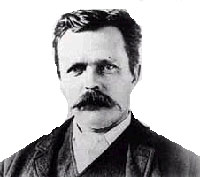John Milne facts for kids
Quick facts for kids
John Milne
|
|
|---|---|

John Milne
|
|
| Born | 30 December 1850 Liverpool, England
|
| Died | 31 July 1913 (aged 62) Shide, Isle of Wight, England
|
| Nationality | British |
| Occupation | Scientist, educator, foreign advisor to Japan |
| Known for | Foreign advisor to Meiji Japan |
| Awards | Lyell Medal (1894) Royal Medal (1908) |
John Milne (born December 30, 1850 – died July 31, 1913) was a British scientist. He was a geologist and a mining engineer. He is most famous for his work on seismographs, which are tools used to detect and measure earthquakes. Milne spent many years in Japan, where he helped set up the first earthquake research society.
Contents
Life of John Milne
John Milne was born in Liverpool, England. He was the only child of John Milne of Milnrow. As a child, he lived in Rochdale. Later, he moved to Richmond, London. In 1895, he moved to the Isle of Wight with his wife. He studied at King's College London and the Royal School of Mines.
Early Adventures
In 1873 and 1874, John Milne worked as a mining engineer. He explored Newfoundland and Labrador to find coal and other minerals. During this time, he studied how ice and rock interact. He also visited Funk Island and wrote about the great auk, a bird that is now extinct.
In December 1873, Milne joined an expedition. He traveled with Dr. Charles Tilstone Beke to find the true location of Mount Sinai in Arabia. Milne used this chance to study the geology of the Sinai Peninsula. He also collected fossils and gave them to the British Museum.
Working in Japan (1875–1895)

In 1876, the Japanese government hired John Milne. He became a foreign advisor and a professor. He taught mining and geology at the Imperial College of Engineering in Tokyo. He traveled across Siberia to reach Japan. This long journey took him three months.
In 1880, a very strong earthquake hit the Yokohama area. After this, John Milne and two other British scientists, Sir Alfred Ewing and Thomas Lomar Gray, began to study earthquakes. They created the Seismological Society of Japan (SSJ). This group helped fund the invention of seismographs. These devices could detect and measure how strong earthquakes were.
While all three scientists worked together, John Milne is often given credit. He invented the horizontal pendulum seismograph in 1880. Milne's seismographs helped him find different types of earthquake waves. He could also estimate how fast these waves traveled.
The foreign professors also trained Japanese students. One student, Seikei Sekiya, became the world's first professor of seismology. His successor, Fusakichi Omori, improved Milne's instruments. These new tools could record even smaller vibrations.
In 1881, John Milne married Tone Horikawa in Hakodate. She was the daughter of Horikawa Noritsune.
Special Award from Japan
In June 1895, Emperor Mutsuhito of Japan asked to meet Milne. Soon after Milne returned to England, he learned of a great honor. The Emperor had given him the Third Grade of the Order of the Rising Sun. This was a very rare award. He also received a lifelong pension of 1,000 yen. This award recognized Milne's important work in seismology during his time in Japan.
Studying Ancient Cultures
From 1882, Milne also studied anthropology. This is the study of human societies and cultures. He helped develop ideas about where the Ainu people of northern Japan came from. He also studied the ancient people of Japan.
Milne dug at the Omori shell mound for several years. He introduced the idea of the Koro-pok-guru. This name comes from an Ainu word meaning "the man under the Fuki" (a large plant). It refers to a small person. An Ainu legend about these small people was first reported by Milne.
Return to England (1895–1913)
In 1895, a fire destroyed Milne's home, observatory, and many of his instruments. He resigned from his posts in Japan. He returned to England with his Japanese wife. They settled at Shide Hill House on the Isle of Wight. There, he continued his studies of earthquakes. He was made a professor emeritus of Tokyo Imperial University.
In 1887, he became a Fellow of the Royal Society. He convinced the Society to fund 20 earthquake observatories around the world. These observatories used his horizontal pendulum seismographs. His network grew to 40 stations worldwide. These stations sent their earthquake data to Milne. This data became the basis for his research. For the next 20 years, Milne's observatory was the main center for earthquake seismology in the world.
In 1898, Milne and W. K. Burton published a book called Earthquakes and Other Earth Movements. This book became a classic textbook about earthquakes.
Milne realized that earthquake readings needed to be shared globally. He published his "Shide Circular Reports on Earthquakes" from 1900 to 1912. This work later led to the International Seismological Summary after the First World War.
In 1906, he gave a lecture to the Royal Society called Recent Advances in Seismology. He received their Royal Medal in 1908 for his important work.
John Milne died on July 31, 1913, from Bright's disease. He is buried in St. Paul's Church, Newport. His wife, Tone, returned to Japan in 1919 and passed away in 1926.
To remember Milne 100 years after his death, a public artwork was created in Newport. A special sign explaining his work was also placed at Shide.
Images for kids
See also
 In Spanish: John Milne para niños
In Spanish: John Milne para niños


